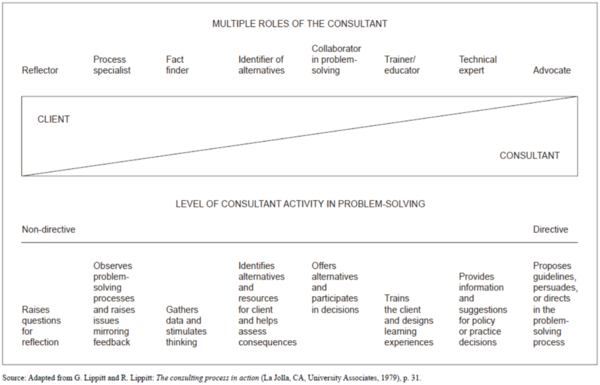

 字體:小 中 大
字體:小 中 大 |
|
|
|
| 2014/02/26 10:46:39瀏覽1361|回應1|推薦1 | |
Further refinement of the role concept
Reducing the various consulting processes to two basic roles or modes is a
simplification that is conceptually useful, but that disregards a number of
situational variables. For practical purposes it is instructive to visualize a greater
number of consultative roles along a directive and non-directive continuum, as
suggested by Gordon and Ronald Lippitt and illustrated in figure 3.1. By directive
we mean behaviours where the consultant assumes a position of leadership,
initiates activity or tells the client what to do. In the non-directive role he or she
provides information for the client to use or not. Here again the situational roles
are not mutually exclusive and can manifest themselves in many ways in a
particular consultant–client relationship. The consultant may find it useful to play
two or more compatible roles simultaneously or consecutively, switching from
role to role as the relationship evolves. These roles are “spheres of influence”
rather than a static continuum of isolated behaviour. Let us examine the different
role choices in response to a client’s needs.
Advocate
In an advocate role, the consultant endeavours to influence the client. There are two quite different types of advocacy:
● positional or “contact” advocacy tries to influence the client to choose particular goods or solutions or to accept particular values;
● methodological advocacy tries to influence the client to become active as problem-solver, and to use certain methods of problem-solving, but is careful not to promote any particular solution (which would be positional advocacy).
In this role, the behaviour of the consultant is derived from a “believer” or “valuer” stance on content or a methodological matter.
Technical expert
One of the roles adopted by any consultant is that of technical specialist or
expert. As mentioned above, the traditional role of a consultant is that of an
expert who uses special knowledge, skill and professional experience to provide
a service to the client. The client is mainly responsible for defining the
objectives of the consultation. Thereafter the consultant assumes a directive role
until the client is comfortable with the particular approach selected. Later in the
relationship the consultant may act as a catalyst in helping to implement the
recommendations made. The consultant may be a resource (content) specialist
in the client’s problem, or a process specialist advising how to cope with a
problem and how to implement change. This particular role makes use of the
consultant’s substantive knowledge.
Trainer and educator
Innovative consultation frequently requires the consultant to carry out periodic
or continuous training and education within the client system. In this aspect of
the helping relationship, the consultant can suggest the most appropriate
learning process, depending upon the situation and the need. The consultant
may design learning experiences, or train or teach by imparting information and
knowledge directly. This work requires the consultant to possess the skills of a
trainer and developer of others’ potential.
Collaborator in problem-solving
The helping role assumed by the consultant uses a synergistic (cooperative)
approach to complement and collaborate with the client in the perceptual,
cognitive and action-taking processes needed to solve the problem. The consultant
helps to maintain objectivity while stimulating conceptualization during
the formulation of the problem. Additionally, he or she must help to isolate and
define the dependent and independent variables that influenced the problem’s
cause, and will ultimately influence its solution. He or she also assists in
weighing alternatives, sorting out salient causal relationships that may affect
them, and synthesizing and developing a course of action for an effective
resolution. The consultant in this role is involved in decision-making as a peer.
Identifier of alternatives
There are direct costs associated with decision-making. While the value of a
decision is dependent upon the attainment of a given set of objectives, in selecting
an appropriate solution to a problem the consultant can normally identify several
alternatives, along with their attendant risks. The alternatives, together with their
economic and other identifiable implications, should be discovered jointly by the
client and the consultant. In this helping relationship, the consultant establishes
relevant criteria for assessing alternatives and develops cause–effect relationships
for each, along with an appropriate set of strategies. In this role, however, the
consultant is not a direct participant in decision-making, but a retriever of
appropriate alternatives facing the decision-maker.
Fact-finder
Fact-finding is an integral part of any consulting assignment, both for developing
a database and for resolving intricate client problems. The consultant’s role may
even be confined to fact-finding. In this case he or she will assist the client system
by choosing the sources of data, using a technique that will get the client more or
less involved in gathering and examining data, and presenting data to the client
in a way that will show where and why improvements are needed. In this role the
consultant functions basically as a researcher.
Process specialist
This is the “pure” process role as described in section 3.4. The consultant
focuses chiefly on the interpersonal and intergroup dynamics affecting the
process of problem-solving and change. He or she works on developing joint
client–consultant diagnostic skills for addressing specific and relevant problems
in order to focus on how things are done rather than on what tasks are
performed. Furthermore, the consultant helps the client to integrate interpersonal
and group skills and events with task-oriented activities, and to observe
the best match of relationships. In this role, an important function of the
consultant is to provide feedback.
Reflector
When operating in the mode of a reflector, the consultant stimulates the client
to prepare and make decisions by asking reflective questions which may help
to clarify, modify or change a given situation. In doing so, the consultant may
be an arbitrator, an integrator or an emphatic respondent who experiences
jointly with the client those blocks that provided the structure and provoked the
situation initially.
整理至:MANAGEMENT CONSULTING
|
|
| ( 知識學習|商業管理 ) |










